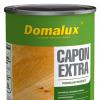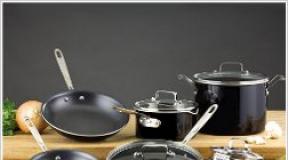How can you remove scale from an electric kettle? How to remove scale from an electric kettle: secrets of housewives. How to descale with table vinegar
Every modern kitchen has a favorite kettle. Some have an electric device, others have a regular enameled one. Over time, any of them needs proper cleaning. Plaque and scale inevitably accumulate on the walls of the vessel and it is not so easy to wash them off. Today we have prepared tips for you that are guaranteed to help you cope with this problem.

Cleaning methods
An electric kettle or a traditional metal one will eventually become covered with scale on the inside. The reason is simple. The fact is that water contains various salts, which form a hard coating on the walls, bottom, and also on the heating element. Especially fast calcareous deposits occur from excessively hard tap water. However, filtered and bottled water only temporarily delays the appearance of scale. This means that serious cleaning of kitchen utensils is inevitable.
Each housewife has her own methods with which she copes with this kind of pollution. For example, someone is trying to get rid of scale detergents. We do not recommend that you do this. After such cleaning, during subsequent boiling, chemicals will be released into the water. Drinking such liquid is very harmful to health.

Under no circumstances should you use abrasives, hard sponges, scrapers or metal mesh . They will hurt inner part product or heating element, after which it may be damaged. You can wash the kettle quickly and easily by using citric acid.
Why do we recommend descaling with citric acid? Because this product is quite affordable, you don’t have to spend a lot of money on it. In addition, it is completely safe and will not harm your health in any way. There are several effective techniques. For old thick plaque, the so-called hot way. If the contamination is not too strong, then it will do cold method. Now is the time to move on to the sequence of actions and description of proportions.

How to properly clean the inside?
If the scale layer on the inside is not too severe, you will need 50-60 grams of citric acid. Pour it into the kettle, fill it to the top very warm water, mix thoroughly. Leave for about an hour, or even better, two. After waiting the time, you just need to pour out the liquid and rinse the kettle with plenty of water. You will notice that the inside of the product has become much cleaner, the plaque has disappeared.
Such regular prevention, at least once or twice a month, will avoid the accumulation of stone deposits and preserve the dishes. The kettle will look like new for a long time.
By the way, upon completion of cleaning, after rinsing, we recommend boiling it in it for about five minutes clean water, and then be sure to drain. This is necessary so that the taste of citric acid is not felt in the drinks.

If available thick layer scale and the above method does not help, you will have to use a more serious method - hot cleaning. To do this, you will again need the kettle itself, citric acid and water. Pour water to the top, add two tablespoons of citric acid and boil the water. Turn off the heat and leave to cool completely. Remember: after each procedure the water is drained.
If small traces of plaque remain on the walls or bottom, remove them with a soft sponge. Did not help? You can safely repeat the procedure. After the second bath, the scale is guaranteed to disappear. Another recommendation regarding the hot method. Never add acid powder to boiling or very hot water.
Citric acid should be poured exclusively into cold or warm liquid. When interacting with boiling water, the acid will immediately begin to foam, which will disrupt correct process cleaning.

A little advice to get rid of old scale. We recommend making this “paste” in the evening. Take equal parts baking soda, which you usually use for baking, and citric acid. Dilute with a small amount of water to end up with a thick paste. Apply it to problem areas and leave overnight. The next morning, you can use any of the cleaning methods we told you about.
Another proven method that will definitely help you cope with even an annual layer of plaque is using a mixture of table vinegar and citric acid. The combination of these two ingredients is well known to many housewives who regularly clean various kitchen utensils.

We warn you that the vinegar should not be “strong”. That is, 70% acid is absolutely not suitable. Take the vinegar that can be used in food: its percentage is much lower, but the effect will be amazing. Please note that using vinegar is absolutely not suitable for cleaning electrical appliances, as it can seriously damage the integrity and performance heating element.
If you decide to clean an enamel or iron teapot using this method, remember the recipe. So, to clean the kettle you will need citric acid and table vinegar. To a glass of warm water you need to add 3-4 tablespoons of regular vinegar. The liquid should be poured into the kettle and left for about half an hour. Then add 2-3 tablespoons of citric acid and put the kettle to boil. If necessary, the procedure can be repeated.

After this cleaning, thoroughly rinse the inside of the product with baking soda. Work with a soft sponge. Then, after thoroughly rinsing the kettle, leave it with the lid open for at least half an hour.
How to clean the outside?
Very often teapots, now we will not talk about electrical appliances, lose their appearance. Enameled or metal product becomes covered with grease stains, carbon deposits and even rust appear. What to do in this case? I would like all kitchen utensils to shine with their pristine shine and cleanliness, and not scare away with their terrible appearance.
Don't worry, there are tips for this case too. As before, you will need citric acid. Small oil stains and burnt fat can be removed with a lemon peel. Simply take a lemon peel or a citrus slice and rub onto the affected areas. Stains will come off easily, and you can easily wash the dishes with a soft sponge.


If the dirt on the surface is too serious, then prepare a special cleaning solution in a large container. You will need a large container that can completely immerse the kettle. Add 100-150 grams of citric acid to warm water, then immerse the kettle there. Leave for about an hour. It is important to remember here: the hotter the water, the more acid, the faster the process will go through cleaning.
Old stains that periodically appear after cooking can be easily removed using a “paste” of acid and baking soda. We talked about the preparation of the mixture and the consistency of the cleaning solution above.
The main thing is to make sure that both powders are completely dissolved, otherwise they may leave scratches on the surface.

Prevention methods
Exist simple rules caring for the kettle, which should be followed:
- To ensure that the heating element and the inside of the product are not often covered with a layer of scale, use only clean water. You can use purified with a filter or buy bottled. If this is not possible, always allow tap water to sit before boiling. Only after this pour it into the bowl.
- Do not boil the same water several times. The best option- Replace with a fresh one each time.
- Clean the inside of the kettle before use. Make sure there are no white flakes in the water.
- If after each use or at least once a day, in the evening, you wipe the inside of your favorite kitchen utensils dry, then scale will appear less often, and the product will last you much longer.

Finally, we have prepared a few more useful tips that will help you keep the kettle in perfect condition:
- If there is no citric acid in the house, then it is quite easy to replace it with regular citrus fruit. You can squeeze the juice from one lemon, or you can simply cut it into small pieces and use it in the methods for getting rid of plaque that were described above.
- In some cases, for example, to clean an iron kettle, it is quite possible regular one will do baking soda, which can also cope with severe stains.
- If you decide to use a mixture of citric acid and baking soda, but these powders are not in the house, then this is not a problem. They can be safely replaced with regular baking powder or baking powder. Their wonderful composition, which helps baked goods become more fluffy, already contains both soda and acid.
- Fans of carbonated drinks, particularly lemonade, can use them as cleansers. You just need to pour the lemonade into a container and leave it there for two or three hours. Leave the lid open to allow all the gas to escape. Then you need to boil the drink in your favorite kettle and that’s it. The result will be pleasantly surprising. Try to use clear drinks, otherwise you risk staining the inside of the glassware a toxic color.
- It will become easier to care for heat-resistant glassware if you wipe it twice a month with a slice of lemon on all sides: outside and inside. By the way, if you don’t have citrus at home, you can take the powder with lemon and dilute it in water. It is better to clean the contaminated surface with a soft sponge or sponge, moistening them in the solution.
- The following product copes well with dark soot stains and smudges on metal products. Lemon juice and medical alcohol should be mixed in equal proportions, then apply the resulting mixture to the stains using a cotton pad and wipe the surface thoroughly. After half an hour, you can wash everything off. If the result is unsatisfactory, the whole process should be repeated.
Electric kettle - convenient device, which is often found on modern kitchens. It is made from different materials: plastics, ceramics, glass and of stainless steel. However, no matter how high-quality and high-tech it is, you will have to think about how to remove scale from an electric kettle.
The question is actually a difficult one. You need to clean an electric kettle at home very carefully, carefully choosing cleaning products: if chosen incorrectly, it can damage the heating element, and you will have to take your favorite equipment to the trash.
Scale is insoluble salts (silicates, carbonates and sulfates of calcium and magnesium) that have pores. They reproduce in them dangerous bacteria. Drinking water that has been heated in a container with a thick layer of scale is very harmful to your health. In addition, heat does not pass through it well, so the water will take longer to heat up, increasing energy consumption and overloading the heating element of the kettle. This leads to rapid breakdown of the device. This is why it is important to get rid of salt deposits.
Cleaning methods
There are two ways to descale an electric kettle:
- mechanical. You will need hard sponges and brushes to scrape off the plaque. This method requires a lot of effort and time. Experts do not recommend using it, because cleaning tools leave scratches on the walls of the kettle, which creates favorable conditions for the proliferation of pathogenic microorganisms in them. It is difficult to remove all the scale, especially with small elements. However, if there is nothing else at hand, then use the mechanical method;
- chemical. You need an acid and an alkali: some salts lend themselves to one substance, some to another. They are found in almost every home - acetic, citric acid and soda. The mechanism of action is simple: these products decompose scale into components that are easily washed off with water.
Chemicals such as acids and soda will help you clean the kettle efficiently and easily at home.
Now there are a lot of tips on how to remove scale. The main thing to remember is:
- Choose your descaling agent carefully: some of them are not suitable for a particular kettle material.
- Consider the degree of contamination. If the scale layer is thin, then you should not use boiling. Pour into the kettle required solution and leave for several hours. If there is a significant volume of deposits, you will have to boil it, and the procedure will most likely need to be repeated.
- Warn your loved ones about cleaning an electrical appliance so that no one is accidentally poisoned.
- Before use chemical methods Scrub the walls of the kettle with a hard, non-metallic sponge for several minutes. Skip this tip if you have a plastic appliance (its walls can be easily scratched).
- Do not fill the kettle completely, otherwise the water will spill out when boiling. Focus on the displacement markings of the device. Usually the permissible maximum and minimum values are indicated there.
- Once cleaning is complete, wash the kettle. Then boil it once or twice plain water and pour it out, thereby removing any remaining chemical substance and smell (otherwise there is a risk of poisoning).
Removing salt deposits is not difficult. But if you need a working electric kettle for long-term use, do not allow a thick layer of scale to form.
Vinegar
You can clean the electric kettle with acetic acid, but this must be done carefully. Use 6 or 9% table vinegar. This method is used for electrical appliances made of plastic, glass and stainless steel, if there is a large volume of hardened scale inside the kettle. Use one of the recipes:
- Fill the kettle two-thirds full with water. Top up the rest with vinegar. The solution must be boiled. Leave it for several hours to allow the water to cool.
- Fill the kettle with water and vinegar in an approximate ratio of 2:1 (that is, you will need a little less than two glasses of acetic acid per liter of water). First boil the water. Then add vinegar and turn on the kettle. After turning it off, leave it for an hour.
Instead of vinegar, you can use vinegar essence 70%: one glass is replaced with 1-2 tablespoons, respectively.
Ventilate the room after using vinegar to remove the strong odor.
Lemon acid
 Citric acid is a softer and more suitable way for electric kettles to remove salt deposits. With its help it is difficult to get rid of hard, old scale, but it is perfect for small stains. Another advantage of this method is its versatility: it is suitable for plastic, metal, ceramic and glass devices.
Citric acid is a softer and more suitable way for electric kettles to remove salt deposits. With its help it is difficult to get rid of hard, old scale, but it is perfect for small stains. Another advantage of this method is its versatility: it is suitable for plastic, metal, ceramic and glass devices.
Gently pour citric acid powder into boiling water (it may hiss and splash out). Ingredient ratio: per liter - 1-2 teaspoons. The solution needs to be boiled for several minutes. Then leave it for a couple of hours.
Instead of citric acid powder, juice is sometimes added. Squeeze a quarter of a lemon into half a liter of water or simply put it in the kettle and wait until the water boils.
Soda
Scale in electric kettle remove with baking soda or soda ash. This is the most gentle method. It is suitable for any teapots. Use caution when using it on colored plastic items as it may leave stains.
Pour baking soda into boiling water. You will need 2 tablespoons per liter. Let the solution simmer for a few minutes, then leave for a couple of hours to cool completely.
Citric acid and soda
It is possible to effectively clean an electric kettle from plaque at home using the following procedure:
- Pour baking soda into a kettle of water. Boil it, then leave for half an hour. Then drain.
- Pour water into the kettle and add citric acid. Next, repeat the steps of the previous paragraph.
Special means
You don’t have to wonder which method to choose, how to use it and whether it will suit your kettle, because modern market household chemicals abounds by special means. The seller of such a store will tell you what to choose.+
Follow the instructions for using household chemicals to effectively, efficiently and safely descale your electric kettle.
There are many different recommendations on the Internet, but not all of them are suitable for electric kettles. It is not recommended to use:
- peelings (potato, apple and others);
- colored carbonated drinks. With caution, you can use colorless ones (“Sprite”, “Schweppes”). The liquid should not contain gases, so first leave the carbonated drink in an open container for several hours. Then pour it into an electric kettle and boil;
- the well-known method of triple exposure (soda, citric and acetic acid);
- pickles.
Prevention
You can defeat even the hardest and oldest raid, but this will take a lot of effort and time. It's better to take it off thin layer scale: you will spend less effort and extend the life of your electrical equipment. For this:
- Clean your electric kettle regularly, at least once a month;
- if hard water flows from your tap, you can use a filter;
- When choosing an electric kettle, give preference to those with a heating coil located inside the body, because it is quite difficult to clean.
Lime inside your electric kettle can quickly damage the device and also harm your health. You can deal with it with acid or soda, which almost every housewife has. In addition, the household chemicals market offers many special products.
Show content articles
When using the electric kettle, salt deposits appear on the walls and bottom. They are characterized by low thermal conductivity, so the heating and boiling time is significantly increased. How to effectively clean a household electric kettle from scale? Follow the advice of users and experts!
The cause of scale and its consequences
Scale consists of insoluble chemical elements that are deposited in heat exchange devices when hard water is heated to boiling water. The precipitate consists of salts from crystals of magnesium carbonate, calcium, magnesium and bicarbonate. Scale formation occurs as follows:
- When water is heated, calcium and magnesium bicarbonate decomposes;
- Bicarbonates are converted to less soluble carbonate;
- A precipitate forms;
- Each time, during the heating process, deposits form and concentrate on the heating element and the surface of the device.
Consequences of scale
Accumulations of deposits inside the electric kettle lead to several difficulties:
 Important! If scale is not removed in time, this can lead to damage to the heating element.
Important! If scale is not removed in time, this can lead to damage to the heating element. How to descale an electric kettle
Crystallized sediment decomposes if exposed to inorganic and organic acids. Therefore, to remove scale that has formed in a household electric kettle, you should use acid-containing products.
Citric acid and juice
Freshly squeezed juice and acid in powder form are used. The product has a gentle, gentle effect on devices made of glass, ceramics, stainless steel and even plastic. The ingrained scale that remains in an electric household kettle can be removed quickly, but to figure out how to remove it, you need to prepare a special solution:
 Important! If the crystallized sediment is not very old, it will disappear after one procedure.
Important! If the crystallized sediment is not very old, it will disappear after one procedure. Baking soda
To clean plaque from the surface of the device, you need to take 1 liter of water and 2 tbsp. l. soda The solution must be boiled and allowed to stand for some time. It's better to wait until it cools down. The mineral deposit will not go away completely, but it will become much softer and can be easily removed by hand.
Important! Plastic colored products cannot be cleaned with baking soda or soda ash.9% vinegar or 70% essence
How to quickly get rid of old layers of scale in your electric kettle and spend a minimum of effort? Use vinegar, which is aggressive on mineral deposits. The solution is prepared as follows:
 Important! The procedure is performed in a well-ventilated area, as vinegar has an unpleasant, pungent odor.
Important! The procedure is performed in a well-ventilated area, as vinegar has an unpleasant, pungent odor. Carbonated drinks
As practice shows, you can clean a household electric kettle from salt scale using carbonated drinks. Coca-Cola, Sprite, and Schweppes contain large amounts of citric acid. You need to release a little gas from the bottle and pour the lemonade into the kettle. The liquid is brought to a boil and left in the kettle for 1-2 hours. Then it is poured out and the jug is washed.
 You can clean your electric kettle using carbonated drinks.
You can clean your electric kettle using carbonated drinks.
Important! The method is suitable for small deposits in stainless steel electrical appliances.
Oxalic acid
Oxalic acid copes with mineral deposits no worse than other means. To do this, do the following:
- Pour the product into a kettle and add 0.5 liters of water;
- Boil the solution and leave until it cools completely;
- Remove any remaining deposits using a kitchen sponge;
- Rinse the device well and boil again.
 In addition to acid, you can also use fresh sorrel
In addition to acid, you can also use fresh sorrel
Cleaners
Special chemicals quickly remove plaque using citric, sulfamic or adipic acid. They come in the form of liquids, powders, and tablets. Use cleaning products strictly according to instructions. A solution is prepared from each product, poured into a kettle and boiled for 30-40 minutes.
 Before and after cleaning
Before and after cleaning
The waste liquid must be drained, and the softened scale must be carefully removed. To remove chemical products, water is boiled 2-3 times.
How to effectively clean an electric kettle from old scale at home? Use gentle products. The following should not be used to clean electric kettles:
- peels of fruits and vegetables. The method is effective only for enameled and metal utensils without electric heating;
- drinks with dyes. There is a risk that colored particles will remain on inner surface teapot;
- triple impact method - citric acid, soda and vinegar. An aggressive mixture can damage the surface of the device;
- brine and marinade. This method is also only suitable for cookware that is heated on the stove.
 Thick formations inside the kettle should not be scraped off with sharp objects. You should not use metal scourers and brushes - they can damage the surface of the dishes. Models with open heaters inside and outside can only be washed with special substances.
Thick formations inside the kettle should not be scraped off with sharp objects. You should not use metal scourers and brushes - they can damage the surface of the dishes. Models with open heaters inside and outside can only be washed with special substances.
To ensure that the product acts carefully, wash the inside of the electric kettle, and then add homemade compounds or chemical reagents. This way the lime “coat” will become loose and dissolve faster.
After removing plaque, the device must be washed with a sponge or soft brush. You need to boil water in it 2-3 times and rinse thoroughly. This way you will prevent poisoning.
Important! Chemical products with abrasive particles can severely scratch the kettle.
Preventive measures
 To prevent scale formation, you should follow simple rules:
To prevent scale formation, you should follow simple rules:
- Once a month, clean the surface and heating element from scale using any of the convenient methods;
- To prepare drinks, use only purified filtered water;
- Before pouring a new one, drain the remaining boiled water;
- Before each boiling, rinse the surface of the kettle;
- Buy devices with a closed spiral;
- Rinse the kettle before adding water.
Watch a video on how to descale an electric kettle
The water in the taps leaves much to be desired, so lime deposits remain on the walls of all devices in contact with it.
Even expensive water filters cannot prevent plaque. Sooner or later it will appear on the surfaces of the appliance and the question will arise of how to clean the kettle from scale.
Traditional methods
Limescale deposits can be removed quickly using special chemicals. But since they are not safe for health, many prefer traditional methods that are time-tested.
Vinegar
Vinegar is not suitable for removing lime deposits from an electric kettle. This product is too aggressive and manufacturers do not recommend its use for such equipment.
You can clean the electric kettle with vinegar only as a last resort, when a large layer of deposits has accumulated.
During the procedure, you will feel it in the kitchen. Therefore, manipulation should be carried out in a room with good ventilation. All windows and vents are opened.
When working with vinegar, wear protective mask to avoid inhaling harmful fumes.
How to descale a kettle:
- For metal devices prepare the following solution: 150 ml of 9% table acid is mixed with 1 tbsp. l. essences. ⅔ of the total volume of water is poured into the container, then the prepared composition is added. The mixture is heated and boiled for half an hour. After turning off the stove, you need to leave the kettle for 5 minutes so that the water cools down a little and repeat the procedure again. This must be done up to 3 times. If there is a strong limescale deposit, the solution is left overnight. After this you need to do well.
- How to descale an electric kettle: devices made from a plastic casing can be damaged if acid is used in pure form, so preparing the solution is a little different. Water is poured into the device to be cleaned with 5 tbsp. l. citric acid and acetic acid. The device is turned on, left until it boils, then turned off. After 15 minutes the process can be repeated. The process is repeated 3-4 times until all plaque is removed. Then wash with detergent.
Descaling a kettle with vinegar is quick and easy. Only such a remedy leaves behind bad smell, even after using detergent.
Boiling will save you from the stench clean water which is carried out at least 3 times.
Lemon acid
Cleaning the kettle from scale is gentle on it and safe for humans. Citric acid is an excellent remedy for getting rid of plaque from any thermal elements.

The advantage of this product is the absence of an unpleasant aroma, which is good if there are small children in the house.
How to descale a kettle with citric acid:
- For conventional appliances: take 2 packs of product, fill the equipment with water, but not completely. Add citric acid to the liquid and boil. The solution should cool, leave it for 10 minutes. Then cleanse and remove plaque. The procedure can be repeated if the plaque has left the walls unevenly.
- How to descale a kettle with citric acid if it is electric: pour a solution of 1-2 tsp into the bowl. products and 1 liter of water. After the liquid boils, drain it and add another one. It is necessary to boil clean water several times.
- If the deposits are small, you can descale the kettle with citric acid even easier. It is dissolved in warm water, pour into the device and leave for 6 hours. Then you need to wipe off the plaque with a sponge.
Descaling your kettle at home is easy and cheap. You can purchase the product at any grocery store.
Sodium bicarbonate
Not only Coca-Cola will do, but also Fanta, Sprite, Lemonade, and Schweppes.
How to remove scale from an electric kettle:
- First you need to release the gas from the drink.
- Pour 500 ml of Sprite into the container, close it and let it boil.
- After boiling, turn off the device and allow the liquid to cool.
- Wash away any remaining plaque with a soft sponge and rinse kitchen appliance several times with clean water.
Coca-Cola and other carbonated drinks contain phosphoric acid. Thanks to it, it is possible to remove lime deposits.
This method is ancient - our great-grandmothers successfully used it. The method is suitable for all types of devices and is accessible to everyone.

The only drawback is that it will not cope with old growths.
How to clean enamel teapot from scale:
- Pour water into the device and place washed apple or potato peelings.
- The liquid is brought to a boil and left for 1.5 hours.
- Then they go over the walls with a sponge.
You can descale an electric kettle using this method if you carry out the procedure several times a week.
If the device has not been washed for a long time, do not waste your time. Apple peels and potato peelings will not help in this case.
Brine
Removing plaque is possible using cucumber or tomato brine. This is an effective folk method.
How to descale an electric kettle:
- Pour brine into the device.
- Bring to a boil.
- Cool, pour out the brine and wash thoroughly to remove plaque.
This tool is not independent. Thanks to the vinegar and salt in its composition, the cleansing process occurs.
Oxalic acid
Of all the cleansers folk remedies oxalic acid considered the most aggressive. It removes heavy limescale deposits.

How to remove scale from a kettle?
Housewives' advice - algorithm of actions:
- I pour a small amount of the product into the device and fill it with water.
- The solution must be boiled and left for 5 minutes.
- I remove any remaining product and clean it with a soft sponge.
Oxalic acid good remedy and many housewives recommend using it. To descale, you can also use fresh sorrel, but it contains a little acid and may require several manipulations.
Household chemicals
The range of household chemicals is large. The products on store shelves effectively remove scale from the kettle.
Before using any products, you should wear gloves and a protective mask.
Antiscale and Major Domus can be used as cleaning agents. These descaling chemical products are effective on all types of stains.
How to remove limescale:
- Antiscale. First, water is poured into the container to be treated, then the contents of the bag are poured at the rate of 100 g per 2–2.5 liters of water. The solution is brought to a boil and boiled for 20 minutes. After switching off, the liquid is left for 2–3 hours so that Antiscale can work better. To clean the kettle, take a sponge and remove any remaining plaque.
- Major Domus. The product is poured into a container and left for 20 minutes. No need to boil. After which the device is washed with plenty of water. If necessary, the procedure can be repeated.
- Cillit another good one industrial product, capable of quickly removing plaque from the surfaces of the inner walls of coffee makers and teapots. It is necessary to fill the container with clean water, dissolve Cillit in water in a ratio of 100 ml for every 500 ml of water. The product is left for half an hour. After which the container must be rinsed. Cillit should be used no more than once a month.
Household chemicals can cause serious irritation of mucous membranes. When using such products, you must wear glasses or avoid touching your eyes with your hands during manipulation.
Removal of limescale must be carried out in a timely manner so as not to resort to the use of household chemicals.
Because of large quantity accumulated plaque on an electrical appliance is not only a source of certain diseases, but also affects the functionality of the device. Before changing the device to a new device, you should try one of traditional methods cleaning.
Scale appears due to impurities contained in low-quality water. During boiling, they settle on the walls of the kettle and spoil the taste of hot drinks. Scale also conducts heat poorly, so a dirty kettle will take longer to boil.
How to clean a kettle with vinegar
The method is suitable for very dirty teapots made of plastic, glass, and stainless steel.
You will need:
- ½ liter of water;
- 1 glass of 9 percent vinegar or 2 tablespoons of 70 percent vinegar essence.
Heat water in a kettle, then pour in vinegar or vinegar essence and leave the solution for an hour. During this time, the scale will soften. Rinse the inside of the kettle with a sponge, boil clean water again and drain it.
How to clean a kettle with lemon or citric acid
The method is suitable for electric kettles made of stainless steel, plastic or glass with a moderate layer.
Not suitable for enamel and aluminum kettles.
You will need:
- ½ liter of water;
- ¼ lemon or 2 tablespoons of citric acid.
Heat water in a kettle and add a piece of lemon or citric acid to the boiling water. Leave the scale to soak for 1-2 hours. Wash the kettle with a sponge and rinse thoroughly. After the first boil, the water will need to be drained.
How to clean a kettle with soda
The method is suitable for any teapots.
You will need:
- ½ liter of water;
- 1 tablespoon baking soda.
Stir the baking soda thoroughly in a glass of water until it dissolves completely. Pour the resulting liquid into the kettle, add the remaining water and boil it. Wait half an hour or an hour and heat the kettle again.
Now you can wash the kettle and boil clean water in it. True, you will have to pour it out afterwards.
How to clean a kettle with soda water
The method is suitable for stainless steel kettles heated on a stove.
Not suitable for aluminum, enamel and electric kettles.
You will need a bottle of any lemonade. The most famous option is cola, but it is better to use a colorless drink (it is important that the composition contains citric acid).
Let the opened bottle of lemonade sit for 2-3 hours to allow the gas bubbles to disappear. Then it’s simple: pour the drink into the kettle and bring to a boil. Then wash and rinse everything thoroughly.
How to clean a kettle with a peel
The method is suitable for enameled and metal teapots with a weak layer of scale.
Not suitable for electric kettles.
You will need:
- ½ liter of water;
- skin of 2–3 apples or pears.
Rinse the cleaning from dirt and sand, put them in a kettle and fill with water. Boil the liquid and leave to steep for one to two hours. A light layer of scale will come off on its own; rub stubborn stains with a dishwashing sponge. After rinsing, the kettle will shine like new.
If you have a particularly spacious kettle, and scale has accumulated on the walls, take more water than indicated in the recipes. The liquid should cover the dirt completely.
How to keep your kettle clean for a long time
- Fill the kettle with soft water. If you don't buy bottled, use a filter. Or at least let the tap water sit for several hours to allow impurities to precipitate.
- Boil water in a kettle no more than once. Better fill it with fresh one.
- Rinse the inside of the kettle at least once a day. And ideally before each use.
- For the sake of prevention, boil a filled kettle with one tablespoon of citric acid once a month.



















